14 min read
What electric underfloor heating system should I choose?
So, you’ve completed your research on electric underfloor heating and have decided that it’s the perfect fit for your project. But, with so much...
5 min read
 Chris Hedges
:
May 26, 2023
Chris Hedges
:
May 26, 2023
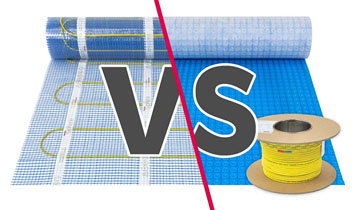
Deciding what is the best electric heating system to use for your project can often be confusing especially when many of them can effectively heat the same floor finish. We often get asked ‘what is better; a pre-spaced mesh mat system such as ThermoSphere Mesh or a heating a decoupling system like ThermoSphere Membrane?’
In this heating blog we’ll help you to decide which system is better for your project by comparing the two. We will cover:
For this blog, and to highlight the key differences, we will be comparing our own ThermoSphere Mesh and ThermoSphere Membrane electric underfloor heating systems.
Electric underfloor heating is installed underneath the floor finish such as tiles and vinyl. It is connected to the mains electricity supply (by a qualified electrician) and controlled with a thermostat. When switched on, the heating cable heats up warming the surface of the floor generating radiant heat. Think of electric underfloor heating turning your floor into one giant radiator. The radiant heat rises upwards and is evenly distributed through the room, which means no cold spots and no fighting to get close to the radiator in winter.
Traditional pre-spaced mesh mat systems (ThermoSphere Mesh)
A pre-spaced mesh mat system consists of a heating cable which is attached to a mesh mat at regular intervals. These systems are available in different outputs, such as 100W/m2, 150W/m2 and 200W/m2. The higher the output, the faster the system will reach the desired temperature. Systems with a higher output are more commonly used for rooms that have a higher heat loss such as conservatories.
Heating and decoupling systems (ThermoSphere Membrane)
Heating and decoupling systems are a more recent addition to electric underfloor heating and come as two separate parts; a decoupling membrane mat and a reel of heating cable.
The decoupling membrane is designed to prevent cracking, lifting and delamination of tiled floors and allows the tiled surface to move independently from the subfloor. It reduces any potential damage to a tiled floor that can be caused by expansion and contraction. The decoupling membrane also provides a waterproofing layer which is ideal for wet rooms.
The heating cable is pressed in-between the studs of the membrane mat which also helps to protect it during installation. You can have different heating outputs too. As an example, using the ThermoSphere Membrane system, you can use a two-stud spacing for an output of 195W/m2 or a three-stud spacing for an output of 130W/m2.
|
|
ThermoSphere Mesh |
ThermoSphere Membrane |
| Commonly used for |
Tile Stone Wood / Timber Vinyl Carpet |
Tile Stone |
Traditional pre-spaced mesh mat systems (ThermoSphere Mesh)
A pre-spaced mesh mat system is one of the most versatile electric underfloor heating systems available and can easily be used to heat a variety of floor finishes. The only difference being the build-up you use. For example, when installing ThermoSphere Mesh under a tile floor finish, you’ll use four layers over the mesh (flexible tile adhesive, uncoupling membrane, flexible tile adhesive and the tile). If you’re installing under a carpeted floor finish, you’ll have three layers (flexible self-levelling compound, carpet underlay and the carpet).
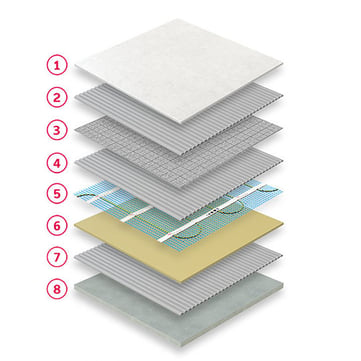 |
Tile floor finish 1. Tile 2. Flexible tile adhesive 3. Uncoupling membrane 4. Flexible tile adhesive 5. Mesh 6. Uncoated insulation board 7. Flexible tile adhesive 8. Concrete substrate |
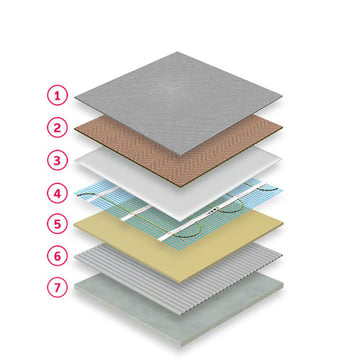 |
Carpet floor finish 1. Carpet 2. Carpet underlay 3. Flexible self-levelling compound 4. Mesh 5. Uncoated insulation board 6. Flexible tile adhesive 7. Concrete substrate |
Heating and decoupling systems (ThermoSphere Membrane)
Heating and decoupling systems are purposefully designed to protect tile and stone floors which is one of the reasons why they are a tiler’s go-to electric underfloor heating system. This type of system is easily integrated into the build of a wet room and doesn’t compromise the tanking process which is another reason why we see this system used often in wet room projects.
When you compare both a traditional pre-spaced mesh mat system vs a decoupling and heating system, you will find on average that the latter is more expensive.
Here is an example for a 2.5m2 heated area:
| ThermoSphere Mesh |
ThermoSphere Membrane |
| 1x Mesh (150W/m2): £89
|
1x Membrane Heating Cable (130W/m2): £77 Total: £122 |
Please note all prices are based on the average market price in May 2023.
You will also need a thermostat to control the underfloor heating system, insulation board to maximise efficiency and any accessories such as tile adhesive for the build-up.
For help choosing a thermostat, read What is the best thermostat to use for underfloor heating? And to understand the importance of insulation for an underfloor heating installation, read Why removing insulation from underfloor heating is costing homeowners.
Firstly, let’s look at the typical build-up you would use for each type of system when installing on a timber substrate and using tiles as the floor finish.
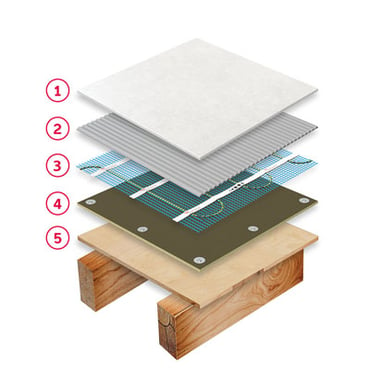 |
Mesh timber substrate build-up 1. Tile 2. Flexible tile adhesive 3. Mesh 4. Coated insulation board 5. Timber substrate |
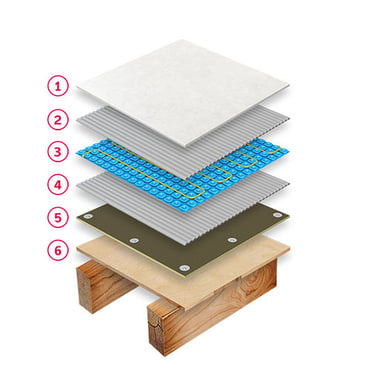 |
Membrane timber substrate build-up 1. Tile 2. Flexible tile adhesive 3. Membrane 4. Flexible tile adhesive 5. Coated insulation board 6. Timber substrate |
Now, onto how to install each type of system.
1. You need complete coverage!
Specifically, when finishing with tile or stone, you must ensure that the heating cable is completely covered in tile adhesive or self-levelling compound. This layer acts as a 'heat sink' to conduct heat away from the cables and into the floor and room. Failure to do this will result in the heating cable overheating over a period with the system failing eventually.
2. Do not forget insulation
Insulation board is always the first thing to get questioned on a quote. It’s often seen as a ‘nice-to-have' but it’s very much a ‘must-have’!
By excluding insulation board, the underfloor heating system will take longer to heat up and the system will cost more to run. Insulation board reduces downward heat loss through the subfloor and most of the heat will be heating the floor above. Insulation board has the potential to improve the efficiency of the system by up to 50% if installed correctly.
3. You must test three times!
Most manufacturers require the installer to test the system. For any ThermoSphere electric underfloor heating system, we require three readings. Without these, the warranty will only be for 25 years rather than a lifetime.
The three tests are:
|
|
ThermoSphere Mesh |
ThermoSphere Membrane |
| Best for |
Heating any floor and room |
Heating, waterproofing and protecting tile or stone floors |
| Commonly used for |
Tile Stone Wood / Timber Vinyl Carpet |
Tile Stone |
| Typical room types |
Any |
Wet rooms Bathrooms Kitchens |
| *How much does it cost to buy? (Inc. VAT) |
From £45 |
From £63 |
| Thickness |
3.5mm |
5.5mm |
| Typical floor build-up height (excluding the floor finish and substrate) |
17mm (concrete subfloor) 14mm (timber subfloor) |
21mm (concrete subfloor) 19mm (timber subfloor) |
| Output (W/m2) |
100, 150, 200 |
130, 195 |
| Who normally installs it |
Tiler |
Tiler |
| Compatible with building management systems? |
Yes |
Yes |
| Warranty |
25 years or Lifetime when registered |
25 years or Lifetime when registered |
*Average market price. Reseller prices vary.
For further detail on electric underfloor heating such as running costs, installation top tips and answers to the most common questions, it can all be found on our heating blog.
If you have a question about anything covered in this article, please contact one of the ThermoSphere team who will be happy to help.
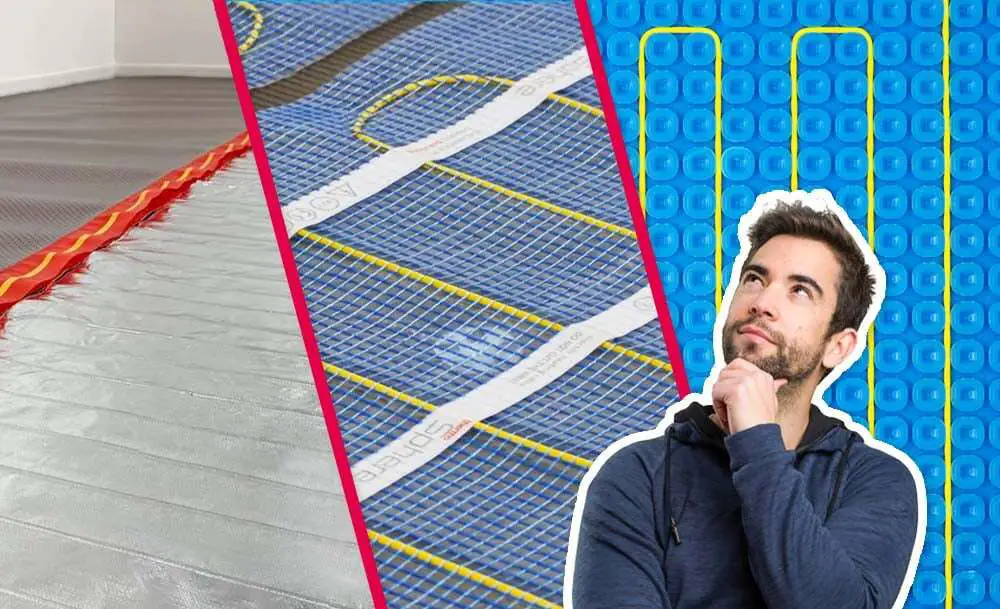
14 min read
So, you’ve completed your research on electric underfloor heating and have decided that it’s the perfect fit for your project. But, with so much...

11 min read
As a British manufacturer of electric underfloor heating, we often get asked ‘What’s the best electric underfloor heating system to use?’. Sounds...

9 min read
In the UK we are becoming increasingly conscious of the rising cost of energy and the impact that heating our homes has on the environment. Electric...